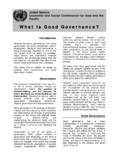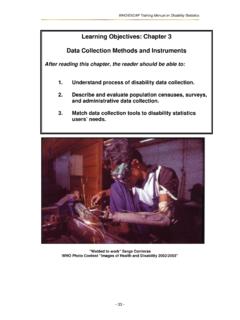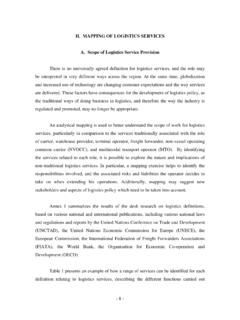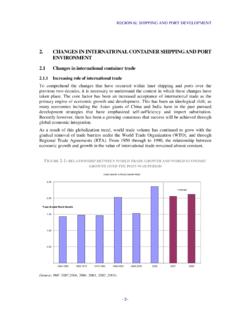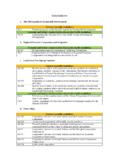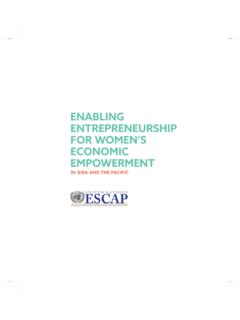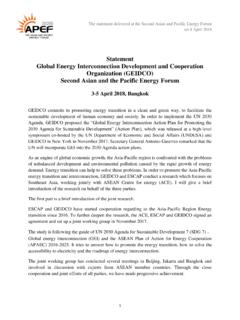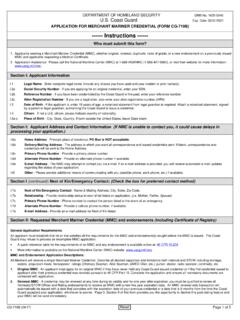Transcription of 3. COMPARISON OF PORT TARIFF STRUCTURES
1 COMPARISON OF PORT TARIFF STRUCTURES 3. COMPARISON OF PORT TARIFF STRUCTURES Modification of the Model Port TARIFF structure for COMPARISON It is difficult to compare port tariffs among ports accurately because of diversity in their systems and regulations, the existence of pricing by long-standing agreements and the influence of the exchange rate. Furthermore, in some cases port charges, TARIFF levels and data are confidential and difficult to obtain. In the current study overall systems of port TARIFF STRUCTURES and types of charges have been surveyed through visiting ports in the ESCAP region and reviewing relevant literature. Port charges are defined as those used in the individual ports . Charging units and recipient and payer of port charges are also compared. The port TARIFF structure used for COMPARISON is the ESCAP/UNDP Model Port TARIFF structure with slight modifications to allow for a more appropriate base for COMPARISON .
2 Nomenclatures for the same kind of port charges are unified for the purpose of comparing port tariffs . The use of a model makes a COMPARISON achievable as any COMPARISON against other approaches would be impossible to document because of the variation in approaches. The characteristics of the port TARIFF STRUCTURES of individual ports or countries have been analysed. Alternative approaches to the simplification, standardization and unification were also identified. As described in the previous chapter, the ESCAP/UNDP Model Port TARIFF structure consists of four service groups: navigation, berth, cargo operations and other business. However, after reviewing the data, slight modifications for the purpose of COMPARISON have been made to the model by adding a lease group . This consists of dedicated costs and rental charges in order to reflect the current trends in the operation of world container terminals that make extensive use of leasing charges.
3 In addition, in the navigation service group, conservancy is consolidated into port dues,4 and minor charges are grouped under ancillary services. The new modified model TARIFF structure for COMPARISON purposes is outlined in table 2-3. 4 In the ESCAP/UNDP model, it was recommended that whenever possible the conservancy charge be incorporated into port dues. 15 COMPARISON OF PORT TARIFF STRUCTURES Table 2-3 Model Port TARIFF structure modified for COMPARISON Charging system Service group Component/ type of service Basis Units Payer Recipient Port dues Size of ship GRT Shipping line Port pilotage Size of ship Time GRT Hours Shipping line Port/ pilotage Association Tug services Tug time involved Size of ship Number GRT Shipping line Port/ Tug owner Mooring/unmooring Size of ship GRT Shipping line Port Navigation Ancillary services Various Various Shipping line Port Berth hire Time of ship alongside Size of ship Hours GRT Shipping line Port Wharfage Volume/weight/size of cargo Tonnes/ TEU/ Consignee/ Consignor Port Berth Ancillary services Amount consumed Various Shipping line Port Stevedorage Volume/weight/size of cargo Tonnes/ TEU/ Shipping line Provider of service Wharf handling Volume/weight/size of cargo Tonnes/ TEU/ Consignee/ Consignor Provider of service Extra-movement Volume/weight/size of cargo Tonnes/ TEU/
4 Consignee/ Consignor Provider of service Special cargo handling Volume/weight/size of cargo Type of special handling Unit Types Shipping line Provider of service Storage Time Tonnes/ TEU/ Days Consignee/ Consignor Provider of service Packing/unpacking Volume/weight/size of cargo Tonnes/ TEU/ Unit type Shipping line Provider of service Cargo operations Equipment/service/ facility hire Hours of use by item Hours Stevedore Equipment/ services owner Other Business Real estate,licensing, management services and consultancy etc. Various Various Hirer Port Dedicated costs Lease area Various Lessee Port Lease Rental charge Lease area Various Lessee Port Notes: GRT = gross registered tonnage TEU = twenty-feet equivalent units 16 COMPARISON OF PORT TARIFF STRUCTURES COMPARISON of TARIFF STRUCTURES Navigation group (a) Port dues Port dues are levied in 18 out of 21 ports in the region included in this study.
5 They are called harbour dues in some ports . The port of Sydney does not charge a port entrance fee in any type of charge. In Ho Chi Minh City, port dues are charged in the name of marine safety dues and in Colombo as entering dues conservancy. Light dues are charged in the following ports Colombo, Hong Kong, Port Klang, and Yangon while light and buoys dues are levied in the ports of Kaohsiung and Yokohama. Conservancy is not levied in most of the ports in the region, with the exception of Yangon port, where conservancy is levied to the cargo as a port entrance fee. It is recommended to consolidate conservancy into port dues. Tonnage is levied in the following ports : Kaohsiung, Osaka, Saigon Port, Shanghai, and Yokohama. It is recommended that tonnage charges be incorporated into port dues. (b) pilotage pilotage is levied in all 21 ports surveyed. However, in some ports of Australia, the Philippines and Singapore the pilot service is provided by the private sector.
6 Pilot attendance/detention fee and premium for pilot officer are additionally charged in some ports . (c) Tug services A tug service charge is levied in most of the ports surveyed, except Chennai and Yangon. It is charged in the name of towage in the following ports of Auckland, Karachi, Mumbai, Sydney and in the name of tug hire in Kaohsiung and Shanghai. Tug boat assistance is additionally charged in some ports . (d) Mooring/unmooring It is called line handling in 12 ports out of 21 included in the study. It is not levied however, in the following ports : Auckland, Bangkok, Busan, Colombo, Jakarta, Laem Chabang, Manila, Port Kelang and Yangon. 17 COMPARISON OF PORT TARIFF STRUCTURES Anchorage is charged in the following ports : Busan, Colombo, Hong Kong, Jakarta, Manila, Mumbai, Port Klang, Shanghai and Yokohama. In Jakarta port, anchorage means port dues. Berthing services are charged in the ports of Singapore and Yangon.
7 (e) Ancillary services Fire and emergency services are charged only if those services are used. This charge is included in the TARIFF schedules of the ports of Bangkok, Colombo and Karachi. Berth group (a) Berth hire Berth hire is charged under different names in different ports . The ports charging as berth hire include Auckland, Bangkok, Chennai, Laem Chabang and Mumbai. It is called dockage in the ports of Busan, Colombo, Hong Kong, Kaohsiung, Manila, Port Klang, Singapore and Yokohama. Berth hire is charged as hire of wharf in Saigon port, as berthage in Shanghai, and in the name of facilities and services in Sydney. In Jakarta port, it is levied in the name of wharfage/quay dues. (b) Wharfage It is usually levied on cargoes as port entrance fee. However, in the ports of Jakarta, Osaka, Saigon and Shanghai, wharfage is levied on ships entering the ports . (c) Ancillary services Ancillary services such as cleaning wharfs, water supply, telephone, garbage and security are included in the TARIFF schedules of some ports .
8 They are charged only when used. Cargo operation group It is difficult to obtain data to assess and compare charges related to cargo operation. There are some discrepancies between general cargo berths and dedicated container terminals. Even in container terminals, the lease rate is dependent upon the individual agreements between port authority and users. Stevedorage is charged in the ports of Hong Kong, Shanghai and Singapore. In Auckland this, plus wharf handling, is levied in the name of goods wharfage. Wharf handling is levied in Colombo. 18 COMPARISON OF PORT TARIFF STRUCTURES As for equipment hire, hiring service is charged in Colombo port. In Mumbai port, mobile crane & equipment is charged, in addition to normal container freight charges, which leads to an abnormally high total port charge. Storage is levied in most ports of the region. It is sometimes charged in the name of demurrage. Packing/unpacking or vanning/devanning is charged in many ports of the region, including Colombo.
9 Weighbridge is levied in some ports including Shanghai. Lift-on/lift-off is charged in Colombo, Shanghai and Singapore ports . It is often levied in the name of mounting/demounting. Off-dock container yard charge is levied in Busan port. Collective charges are levied based on the terminal lease in most of the container terminals, including Busan, Hong Kong, Singapore and Yokohama ports . Characteristics of port TARIFF STRUCTURES by country Australia - Sydney Navigation service group Tonnage rates are applied to vessels. Light dues are charged to vessels. pilotage and mooring services etc. are specified in the group. Berth group Berth hire is charged under the title of ship's berth hire. Wharfage is charged as cargo berth hire. China - Shanghai Navigation service group Tonnage due is charged for port dues based on NRT ( yuan renminbi). Quarantine is charged per ship's visit (1,560 yuan renminbi).
10 Line handling, pilotage , towage, launch hire and husbanding fee (agency fee) are specified in the navigation service group. 19 COMPARISON OF PORT TARIFF STRUCTURES Berth group and cargo operation group tariffs of the public berths specify berthage, stevedorage (lump-sum charge) and special cargo handling etc. In the private container terminals, stevedorage (contract rate), berthing fee, weighting, line handling, lift-on/lift-off, and storage charges are applied collectively based on contract. Hong Kong, China - Hong Kong Navigation group Light due (HK$57/100 NRT/Call) and anchorage due are levied separately. Mooring/unmooring, towage and pilotage are specified in the group. Berth group For the public cargo working area, berthing permit is charged to shipping lines. For the private container terminals, dockage is charged in line with or separately from stevedorage. Port tariffs in the private container terminals are dependent upon the negotiation between the terminal operators and shipping lines.
